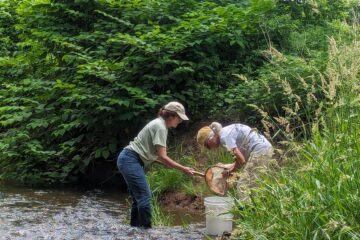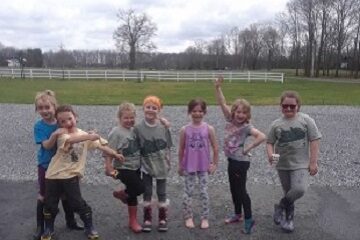Learn a new language while you’re home: the language of birds!Spring is here, birds are migrating back and they have a lot to say. So, put on your listening ears, venture outside and give our avian friends your attention! Created by Tracy Gordon, RHA Educator
 Level: Anyone who has a fondness for birds
Level: Anyone who has a fondness for birds
Lesson Duration: 20 minutes to multiple hours, depending on attention span of child (or adult).
Setting: Outdoors in your backyard, a nearby park, while walking in the neighborhood, etc.
Materials:
- Recording device (most of us have phones) to record the singing
- Bird ID App downloaded onto Phone or Laptop, or one of the websites below (see Resources)
- Journal or sketch pad to illustrate the bird or jot down any applicable notes
- Binoculars, if you have them
Background Information: Birds are known for their delightful songs. They sing, warble, squawk and chirp in order to communicate with each other. Many birders learn the songs and calls of bird species to help identify them. Most times a bird is heard before it is seen. Ornithologists use interesting tricks and mnemonics to help them learn the songs. Just as we describe a turkey’s sound as “gobble, gobble, gobble” we can describe an American Robin’s song as “cheer-up, cheer-a-lee, cheer-ee-o, whinny”.



So what are birds saying to each other? Stay out of my territory? Would you like to be my mate? Look out, danger behind those bushes? There are two main types of group of vocalizations that birds use to communicate.
- Songs are elaborate and long and are usually used to attract a mate, or defend territory.
- Calls are short chirps or brief songs that warn of threats, reveal information about food, or identify family members.
As you learn to recognize bird sounds and calls, think about what they might be communicating to one another.
The Activity:
- Train your birding ears by tuning into Bird Song Hero
https://academy.allaboutbirds.org/features/bird-song-hero/bird-song-hero-tutorial
- Venture outside and simply listen.
- As you hear birds try to locate where they are and view them with binoculars (if you have a pair). Jot down notes, draw a site map of where you think the bird is, sketch a picture in your journal.
- Think about what the bird might be saying and to whom.
Can you recognize a helpful mnemonic?
- At this point you could try recording.
- When you come back indoors you can research the birds that you heard/saw on the links provided
Resources
https://www.audubon.org/bird-guide
https://www.audubon.org/app Bird Guide App
https://www.allaboutbirds.org/guide/
https://merlin.allaboutbirds.org/ Bird Guide App
Wrap Up:
- Were you able to recognize distinct bird songs and/or calls?
- Make up your own mnemonic to help you remember distinct songs.
- Could you see the bird that was singing/calling?
- How could you improve your chances of hearing birds?
- Do birds sing more at certain times of day?
- Write a story/draw a picture of the birds you heard and what they were saying to each other. Be creative.
Vocabulary:
Mnemonic: Something that is used to aid the memory
Ornithologist: A scientist that studies birds
Vocalization: A sound made with the voice
Sources:
https://cdn2.hubspot.net/hubfs/95627/K-12%20Education/Bird_Communication_Lesson_FINAL.pdf?
https://academy.allaboutbirds.org
https://www.birds.cornell.edu/home
https://www.audubon.org/news/how-start-identifying-birds-their-songs-and-calls
How did you like this activity? Please share any questions, comments, or photos that you and your child have on the Raritan Headwaters Learning Community Facebook Page!
More Raritan Headwaters Learning Resources



